Grapes are a tasty and capricious shrub. This plant requires careful and timely care, as a result of which it will produce ripe and delicious-tasting berries.
White coating on leaves is a common problem in grapes.
However, grapes also have negative sides - a tendency to frequent diseases. Thus, a white coating can portend serious problems, although it seems that such a coating does not harm the shrub.
Diseases
If you begin to notice the appearance of white spots on your vine, then you should carefully consider the nature of the plaque and, in accordance with it, take urgent treatment measures. Otherwise, serious damage to the bushes or even death is possible.
You can determine which disease the grapes are infected with based on the following signs:
- If the surfaces of the berries and leaves of the plant are covered with a white coating, similar in appearance and consistency to flour, then the grapes are infected with oidium. It is worth noting that if you pick a diseased grape or leaf, the virus will instantly die and the white coating will begin to disappear.
- If yellowish oil stains appear on the leaves of your vine, which when wet create a fluffy snow-white coating, then the grapes have mildew disease.
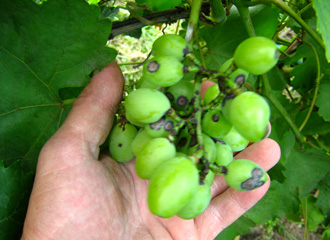
Powdery coating on berries and leaves indicates oidium disease
Treatment
The need for prompt healing procedures for these diseases is very great. The further growth, richness of the berries, and most importantly, the life of the bush depends on how quickly you detect and accurately determine the diagnosis.
How to treat grapes? In order to select the maximum effective ways To heal a bush from the above diseases, you must first carefully understand the diagnoses.
In addition to the presence of white plaque, the following symptoms appear with oidium:
- Over time, the plaque begins to darken, the leaves turn yellow and die. It is important to take into account that the affected leaves do not fall off even after they die and continue to hang tightly on the bush.
- As soon as new plants appear, they are immediately infected with the fungus and grow completely covered in white coating.
- In cold weather, infected grapes begin to die and die completely in 2-4 weeks.

Grapes affected by oidium quickly die
What are the consequences of this disease
Grape growth slows down significantly. In some places you can see black spots, which show that the bush is slowly dying.
Oidium has a negative effect on berries. Slightly less than half of the crop is completely painted in White color and dries out, the rest of it ripens tasteless, soft and has a rotten, spoiled appearance.
It is important to note that cold air and lowering the temperature to sub-zero will not help get rid of fungal infection by oidium. The viruses will simply “overwinter” this period, and in the spring they will continue to infect shrubs.
It is also worth considering that oidium can be transmitted by wind, which allows the disease to infect absolutely the entire vine in the shortest possible time.
Remember that the warmer the place where your grapes grow, the faster the oidium viruses multiply.
Why does this disease occur?
There are many reasons for the appearance, but the most common of them are the constant presence of the vine in uncomfortable conditions, such as rain, drought, heat air. It could also be due to a lack nutrients in the ground, necessary for the normal growth and development of the bush.

Oidium can occur both after drought and as a result of rains
Mildew
Look at the underside of the leaves of your plant; if you see a fluffy coating there, then the grapes are infected with mildew. It is worth noting that this disease is very difficult to notice at the initial stage. Usually people realize that their bush is infected with a fungus only when the disease has become quite serious.
The onset of the disease is accompanied by the appearance of yellowish spots on leaves that grow quickly. After which the leaves turn brown, dry out and fall off.
It is worth noting that the fungus actively reproduces in the cold season, that is, as soon as the mark reaches 10 degrees below zero, mildew begins to multiply and infect plants.
The viral infection begins to infect the grapes from above, gradually moving down and at the very end infecting the fruits of the plant. Grapes that have been attacked by a fungus become dark brown in color and subsequently dry out.
It is important to know that this disease can be noticed in bad weather, as fluff appears on the leaves. On hot days, symptoms in the early stages are almost impossible to notice even for an experienced gardener.
You can completely get rid of this disease only by completely removing all infected bushes. Please note that mildew bacteria spores can live quietly waiting for new grapes for about 20 years!
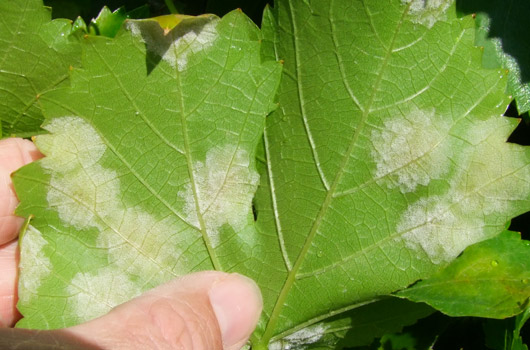
A fluffy coating on the underside of a leaf indicates mildew disease.
Necessary measures
If you notice a white coating on your plant, and after looking closely, you determine that the vine is infected with oidium or mildew, you should take action as quickly as possible:
- Prepare a weak solution of potassium permanganate. To do this, add a few crystals to 1 liter of water so that the liquid acquires a slightly pinkish color. Spray both infected and healthy shrubs with the resulting solution once every two weeks. Please note that fungi can be located both above and below, so you need to spray the entire plant without missing a leaf. It is advisable to carry out this procedure in early spring, when the grapes are just beginning to wake up and prepare for active growth and flowering. Even if your plant is not infected, it is recommended to spray it with this solution twice a year for prevention. During flowering, you should not use a mixture of manganese with water, otherwise there is a high probability of the solution getting on the berries, and through them into the human body.
- Purchase special products to combat these diseases at garden stores. It is important to know that the use of one type of drug will cause the bush to become addictive, and the virus will develop immunity to it. Therefore, it is necessary to alternate means of combating diseases. For example, purchase three different products that treat one disease in your grapes. Use each remedy in periods. So, in two periods, the grapes and the disease will forget about the first remedy, and this will make it possible to combat the infection as effectively as possible.
- In case of severe infestation, use a solution of colloidal sulfur. So, for a bucket of water you will need 10 g of sulfur. Spraying can be carried out every week until the grapes bloom.
- When the disease is advanced, it is better to completely eliminate the most infected shrubs, and carefully spray the rest. Until the grapes have completely recovered, you should not focus on the berries and pay more attention to treatment. So, there is no need to harvest until the bushes have recovered from viral infections.

Calloidal sulfur effectively fights mildew
Prevention
Prevention measures should be applied constantly. You shouldn’t be too sure that your care is enough to prevent the grapes from getting sick. The virus can overtake even the most well-groomed shrub and destroy all the others behind it.
The plant should be sprayed with antifungal solutions in early spring, when the grapes are just beginning to grow, and in late August, when the bush is preparing to go into hibernation.
Particular attention should be paid to the soil. Because the grapes absorb great amount vitamins and nutrients, then the earth quickly loses its beneficial features. If the soil is not fertilized, the shrub will become susceptible to fungal diseases.
To fertilize the soil, use special mixtures that are sold in stores. Various fertilizers are also excellent, containing phosphorus, potassium, magnesium and many other minerals.
It is good to place iron near the roots of the grapes, which will not only enrich the soil, but also give the bush a lot of strength for active development and flowering.
You should also monitor the atmosphere of the vineyard. So, it should be sufficiently humid, light and spacious. Violation of at least one condition will affect the health and quality of the berries.
It is also necessary to trim and tie up the bush in a timely manner.

Stores sell ready-made fertilizers for grapes
What to do with infected grapes
Those bushes that have become infected and have not responded to any treatment must be dug up and burned. Please note that the destruction procedure must be carried out away from the vineyard, otherwise the viral infection may disperse in the wind and reappear on the grapes.
The soil after spoiled plants should be left for 1-2 years, constantly digging up and fertilizing. Why is this necessary? This procedure is necessary to strengthen, enrich with minerals and useful substances soil.
It is a mistake to think that in case of oidium or mildew diseases, you can only remove infected leaves and berries, since viruses affect the entire bush and appear only in these areas.
It is advisable to plant grapes at an optimal distance, so that if a fungus gets on one bush, it does not spread to the rest in a short time.
Grapes are a worthy plant that requires good and timely care. It is how and how much you take care of the bush that determines its condition and the quality of the fruit.
Remember that if the leaves turn white, this does not mean that the plant is simply covered with something as a result of weather conditions and everything will go away on its own. This sign warns you of infection and active development of fungus on the grapes, which will lead to death and damage to the crop.
The main thing is to always monitor any changes in your vine, clarify the correct diagnosis of the disease and take prompt treatment measures. To ensure that your grapes grow healthy and produce only tasty, juicy berries, it is recommended to carry out preventive maintenance at least 2 times a year.
Main diseases and pests of grapes and methods of combating them
Grape plants are damaged by numerous pests, viral, bacterial and fungal diseases. They often suffer from unfavorable soil and weather conditions. Annual grape harvest losses are about 30%, and if protective measures are untimely or poorly carried out, they reach more than 50%.
To preserve the grape harvest from pests it is necessary to apply a system of agrotechnical and chemical measures, making maximum use of natural factors to regulate their volume and harmfulness.
Grape diseases are divided into infectious and non-infectious. Of the infectious diseases, the most harmful are: mildew, oidium, anthracnose, gray and white rot.

Fungal disease. Affects leaves, shoots, inflorescences, berries. Widely distributed in Europe, Asia, America and Australia. It mainly develops in areas with a warm and humid climate (Middle Asia and Transcaucasia), in the humid subtropics of the Black Sea coast of the Caucasus, in Moldova, and Ukraine.
The causative agent is Gloeosporium ampelophagum Sacc. It overwinters on the affected organs of grapes and persists for a long time (up to 5 years) in the form of mycelium, pycnidia and sclerotia. The spore produces up to 30 generations per season. Precipitation in the spring causes early damage to young leaves and shoots of grapes that are just beginning to develop.
Signs of the disease. Brown spots appear on the leaves, surrounded by a dark white border, which often merge. In places where there are stains, the tissue dies and falls out. On grape shoots, depressed brownish-brown and then pinkish-gray oval spots with a dark border are formed, often involving entire internodes. Later, the tissue cracks, forming deep ulcers. Shoots often break and dry out. Similar symptoms appear on the ridges and petioles of leaves. Affected inflorescences turn brown and dry out. Brownish or gray depressed angular and round spots with a dark border form on the berries. Strong spread and outbreak of the disease in vineyards is observed in rainy weather. Anthracnose causes great damage to viticulture.
Fighting methods: introduction of anthracnose-resistant grape varieties, timely treatment with contact and systemic fungicides. The timing of the treatments is the same as against mildew.
Preparations: Antracol, Acrobat, Bordeaux mixture, Kuprosat, Ridomil, Thanos, Horus.

Signs of the disease. The first sign is the appearance in summer of a so-called oily spot of round shape of any size on the upper part of young and on adult, but still growing leaves. In humid weather, a white powdery coating forms on the underside of the stain. Gradually, necrosis (cell death) appears on the tissue of the spot, covering an increasingly larger part; the affected tissue first turns yellow, then the spot may become reddish-brown, with pronounced processes of dying and drying. Severely affected leaves fall off; green shoots may have no leaves. After the initial appearance on the leaves, the disease can spread to the inflorescences (or clusters), which is very dangerous for the harvest. The generative organs of grapes are usually more susceptible to mildew than the leaves. On inflorescences (or clusters), mildew affects the ridge, on which elongated spots of intense green color appear, as if saturated with water. The spot tissue later dies, this disrupts normal sap flow and causes part of the inflorescence (cluster) to dry out. If the mycelium penetrates the peduncles (peduncles) and flowers (ovaries, young berries), then the inflorescence (cluster with ovaries of berries) becomes covered with a white coating of sporulation of the fungus, and then the buds and flowers dry out and fall off. The optimal temperature for the development of the disease is 20-25? C and high humidity. Up to 16 generations of the pathogen can develop during a season.
Methods of struggle. Growing complexly resistant varieties, mulching the soil under the bush, timely application of potassium-phosphorus fertilizers, removal of shoots and preventive treatments with contact and systemic fungicides.
Approximate timing of treatments: the first is carried out when the young shoots have grown to a length of 15-20 cm, the second treatment is carried out before flowering, the third after flowering when the berry reaches the size of a pea.
Preparations:
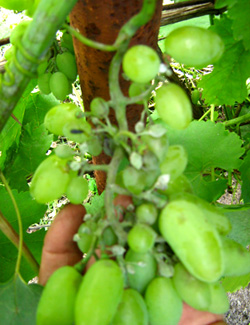
Oidium (powdery mildew) - along with downy mildew, the causative agent of true powdery mildew, also called oidium, causes the greatest damage to viticulture. The disease is caused by the fungus Uncinula necator Burril. It was brought from North America.
Signs of the disease. Soon after the grape shoots begin to grow, you can find among them those that are stunted in growth, their leaves look curly, and they are completely or partially covered with grayish-white dust. From June this grayish-white coating is more often visible on the upper and lower sides of the leaves. All inflorescences and clusters of grapes and the tops of shoots may look as if sprinkled with ash or flour. Affected inflorescences die. Infected berries dry out and pea-sized berries burst and collapse molds or dry out in dry weather. Oidium causes great damage, primarily through the destruction of grape bunches. The incubation period, i.e. the time from the settling of conidia to the appearance of fungal plaque, is 7-14 days, depending on the temperature. Conidia germinate at temperatures above 5 °C, but best at 25-35 °C. The fungus appears mostly in moderately warm and damp weather, but can also spread quickly during periods of low humidity. Poorly ventilated locations, as well as clusters inside heavily leafed grape bushes, are particularly susceptible to attack.
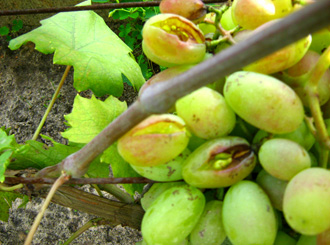
Methods of struggle. Agrotechnical techniques that promote ventilation of bushes (tying up shoots, pinching, breaking off shoots, weed control). The timing of the treatments is the same as against mildew.
Preparations: Thanos, Strobi, Horus, Tiovit, Topaz.
Signs of the disease. In the vineyards, gray rot in cold and damp spring weather coats the budding eyes and young shoots. In poorly ventilated plantings, in humid weather, it forms gray plaque, covering all parts of a bunch of grapes, which becomes dusty when touched. Often the entire bunch turns into an unattractive, mushy clump. In dry weather, the development of the fungus is limited to the first berries affected by it, which then shrivel. Unilateral fertilization with nitrogen increases the susceptibility of bushes to disease. With the onset of dry weather, the spring infection almost always stops. Affected grape inflorescences or parts thereof die, turn brown and dry out in dry weather, resembling signs of ridge paralysis. In viticulture, gray mold is especially dangerous as a causative agent of rot of berries and ridges. When infecting grapes early, it is important that this fungus primarily affects wounded areas or weakened parts of the grape bush.
Methods of struggle. In principle, they do not differ from the methods of combating mildew and oidium. Timely treatment of plants with fungicides prevents the development of diseases.
Black spot (Phomopsis, escoriosis, shoot dieback). The causative agent of the disease is a higher fungus from the class Deuteromycetes.
The disease is most harmful in viticulture areas with high humidity air. It affects all green organs and woody parts of bushes.
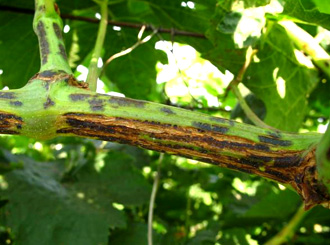 |
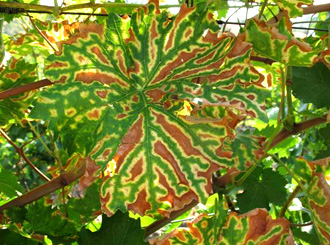 |
Signs of the disease. On lignified annual shoots and perennial wood, the disease causes discoloration of the bark; spots appear, as a rule, on the first 6-7 internodes, and with severe development of the disease, it appears on fruit links, sleeves and trunks. On faded areas of the bark at temperatures above 10°C, the fruiting bodies of the fungus are formed - numerous black dots - pycnidia. If the mycelium grows deeply into the wood, then rotten areas are formed, which first weaken the growth and later cause the death of entire branches. The first signs of the disease on the green organs of the grape bush appear in June, primarily on annual shoots in the form of black-brown, round or oval dots. As the shoots grow, most of the points increase in size, they often merge into elongated longitudinal spots, the vine tissues crack and become light brown. The darker edges of the tear become corky and give the affected areas a scab-like appearance. appearance. Leaves are also often infected, and less commonly, the tendrils and ridges of grape bunches. Even the flower caps are sometimes covered with black spots. Oval and angularly outlined necrosis appears on the affected leaf blades - mostly near a more powerful vein, which is completely black. Leaf necrosis is surrounded by a light border of compacted tissue. Due to the tension of the tissue, the leaf blade ruptures. Severely affected leaves turn yellow prematurely. Sometimes ripe berries are affected and turn dark purple.
In spring, at temperatures above 8°C and the presence of a water film, spores emerge from the pycnidia. In rain or heavy dew, the masses of spores spread and are spread partly by drops of water, and after drying, also by the wind, insects and mites. If the spores land on the green parts of the bush, they germinate at temperatures from 15 to 35°C (optimum - 23°C) and a relative humidity of at least 85%.
Grape plants often become infected with black spot through wounds caused by broken shoots, as well as other mechanical damage.
Methods of struggle. It is quite difficult to fight against the mycelium of the fungus, which penetrates deep into the wood tissue and grows quickly under the protection of the host tissue. The fungal spores are protected from fungicides by a thick layer of cells. Chemical control using currently known active substances against the mycelium of the fungus does not produce results. Therefore, it should be directed against the fruiting bodies of the fungus and, especially, against spreading spores. In case of severe damage, in the fall after the leaves have fallen or after pruning (winter treatment), the grape bushes should be sprayed with copper contact preparations. Drying sleeves must be cut out. When eradicating spraying, you need to ensure that the bushes are thoroughly washed. In spring, fungicides are applied when 2-3 leaves appear. Further spraying against black spot to protect young growth coincides with treatments of plantings against mildew and oidium. Based on the fact that black spot is a chronic disease of grapes, it cannot be completely eliminated in a short period of time even with repeated careful winter and spring treatment.
Preparations: Anthracol, Bordeaux mixture, Kuproxat, Ridomil, Strobi, Thanos, Horus, Copper oxychloride.
In addition to the development of diseases, the bushes and grape harvest are under constant threat of damage by many pests. These are phylloxera, mites, leaf rollers.
Phylloxera is the most dangerous pest of grapes. Lives only on grape plants. Homeland of phylloxera - North America, from where it was brought to Europe.
Grape phylloxera is a greenish-yellow aphid that is barely visible to the naked eye. There are two main forms of phylloxera known: root and leaf, or gall.
Individuals of the root form of phylloxera are first lemon-yellow and then yellowish-brown in color, with a pair of short three-segmented antennae and a long proboscis. This form of the pest lives on the roots, underground trunk of the grape bush and on cuttings of European, American varieties and hybrids - direct producers. European varieties are most sensitive to this form of phylloxera; Rootstock varieties and hybrids - direct producers - are less damaged by it.
Damage to the root form of phylloxera occurs as follows. The larva pierces the tissue of the root or trunk with its proboscis. Enzymes are released into the injection site with saliva that help convert proteins, fats and carbohydrates of the cell into the form most accessible to phylloxera. Thus destroyed a large number of cells that make up tissues.
Leaf phylloxera does not develop on European varieties. It lives only on rootstock vines and on some varieties of hybrids - direct producers. In places where the larvae stick to the leaves, swellings called galls form on the underside of them, in which the larvae develop. When a plant is very heavily infested with a pest, galls appear on the stem, tendrils, and leaf cuttings.
Phylloxera develops differently in different soils. There are soils favorable for its life. These include fertile light structural chernozem, slate and rocky soils. Less favorable for phylloxera are heavy, structureless, floating soils - clayey, solonetzic, loess, silty. But there are soils in which phylloxera cannot develop - these are sands. All European varieties can be grown on them on their own roots, despite the fact that the site may be located in a phylloxera zone.
Methods of struggle. A radical method of combating phylloxera is that when it is detected in a vineyard, all bushes in the outbreak and in the surrounding quarantine zone are completely uprooted.
A chemical way to combat root phylloxera is to fumigate the soil with special preparations (fumigants). Currently this method is not used.
Actelik, Zolon, Confidor and other insecticides are used against the leaf form of phylloxera.
The most effective and most common way to protect against phylloxera is to grow grapes on phylloxera-resistant rootstocks.
Common spider mite - polyphagous pest. Lives on more than 200 species of plants, including grapes. It got its name from the fact that its habitat is always entwined with cobwebs. It settles on the underside of leaves and feeds on the contents of cells. Leaves damaged by spider mites turn yellow, and in colored varieties they turn red - first along the main veins, and then over the entire surface. Subsequently, the leaves turn brown, dry out and fall off.
This damage leads to a decrease in sugar content and an increase in acidity. Growth decreases and shoot ripening worsens.
During the summer, spider mites can produce up to 12 generations.
(phytoptus).
It is very common in the vineyard, but not all varieties are damaged to the same extent. It lives, as a rule, on leaves, much less often on inflorescences. In the habitats of thistle, tubercles form on the upper side of the leaves (in contrast to the leaf form of phylloxera, which forms galls on the underside of the leaf). Each tubercle corresponds to a saucer-shaped depression on the underside of the leaf, densely covered with hairs. At first the hairs are pinkish-white, and then become brownish or reddish. Due to damage, leaf photosynthesis is disrupted. If itching affects the inflorescences, the petals become dense, turn red and fall off. Most often this happens with hybrids - direct producers. Does not cause any special changes on the bunches.
The itch overwinters under the scales of the buds, at the base of the shoots, in cracks in the bark. In the spring it moves to the buds and attaches itself to them. After the development of the latter, it settles on the underside of the leaves. It produces several generations during the year.
Methods of struggle. To protect vineyards from mites, acaricides are used: Neoron, Omite, Sunmite, Aktelik, Talstar, sulfur preparations. Practice shows that the threshold number of mites occurs in the second half of May, that is, during the hatching period of the first generation of cluster budworm caterpillars. In this regard, it is advisable to carry out treatment against ticks and leaf rollers simultaneously, using insectoacaricides.
Leaf rollers. In Ukraine, there are three types of leaf rollers - biennial, bunch and grape.
Biennial leaf roller. The caterpillars of this pest damage inflorescences, young ovaries and grape berries. They can also feed on privet, buckthorn, black currant and euonymus. One caterpillar of the first generation destroys about 30-50 buds, and of the second - up to 20 berries. Various microorganisms develop on damaged flowers, buds, ovaries and bunches, causing rotting first of individual berries and then of entire bunches.
The biennial leaf roller is a small butterfly (wingspan 14-16 mm) of a grayish-yellow color with a black transverse stripe in the form of a triangle on the front wings. The caterpillar is brownish-red in color, up to 1.5 cm long. The pupa is yellow-brown, 0.5-0.7 cm long, with four pairs of hooks at the posterior end.
Bunch leaf roller. The caterpillars of this pest cause great harm inflorescences, ovaries and grape berries.
The butterflies are brown in color, with a beautiful pattern of bluish and brownish spots and stripes on the front wings, the wingspan is 12 -14 mm. The body length of the caterpillars is 10-13 mm, their color is green or gray-green. The pupa is 5-6 mm long, from dirty green to dark brown.
Grape leaf roller. Its caterpillars in the spring gnaw out swollen buds, twist and eat young leaves. Very often they damage the inflorescences and ovaries of grapes. Medium sized butterflies. The fore wings are light yellow in color with three light brown stripes, well defined in males. The second pair of wings (back) is gray. The caterpillar is dirty gray or greenish in color, with two pairs of light tubercles with bristles at the ends.
Methods of struggle. After opening the grape bushes, the trunk and sleeves must be cleaned of old bark. The removed bark, and along with it the overwintering pupae of the pest, should be burned. However, the main means of combating leaf roller caterpillars is the chemical method.
Processing is carried out in following dates: against the biennial leaf roller, two sprayings 12-15 days after the start of flight of butterflies of the first and second generations, the third - 10-12 days after the second treatment; against the grape budworm for the first time 12-15 days after the start of flight of the first generation butterflies, the second time ten days after the first (usually on the eve of flowering of the grapes), the third time 12-15 days after the start of flight of the second generation butterflies; against the grape leaf roller, the first time during the swelling of the buds, the second time after they bloom.
For protection use: Bi-58, Zolon, Talstar, Fury.
It is important. When spraying a vineyard against diseases, you can add pest control drugs to the working solution, mixing them in one container.
Be sure to use personal protective equipment and observe the timing of entering the area after pesticide treatments.
If a white coating appears on the grape leaves, this means that the plant is infected with oidium or powdery mildew. The disease can affect any part of the plant throughout the growing season. Particularly dangerous is damage to the inflorescences, as well as the ovary, which can destroy 80% of the crop.
Oidium appears on the outside of the leaf. First, small lonely spots of white or yellowish, or less often gray, appear on it. After some time, the entire surface of the sheet becomes covered with a white coating, which is not very firmly attached to the sheet and can be erased when exposed to it. In places of contact with the surface on the sheet, you can see brown spots. With further progression of the disease, a white coating begins to move to the inner surface of the leaf, and then to other parts grapevine(leaf stalks, shoots and flowers). If oidium develops on a plant for a long time, its leaves soon acquire a brown tint and gradually dry out, the inflorescences become covered with a coating and then fall off.
On the shoots, the appearance of oidium can be noticed by dark brown spots that can ring the vine. Infected shoots develop poorly, so they do not survive until next spring.
Powdery mildew can be seen on berries by a white coating, which over time turns into dirty gray spots. Damaged berries slow down their development, acquire a brown tint and soon dry out. If the disease manifests itself when the grape bunches are fully formed, the berries crack, and in the presence of persistent damp weather they begin to rot.
The disease progresses quickly in hot weather, which is combined with highly humidified air. The fungus can overwinter on the plant or in fallen leaves.
Fighting white bloom on grape leaves
The best way to combat the disease or prevent its development is to plant varieties that are not affected by it. It is also necessary to carry out systematic thinning of the crown in order to improve ventilation, spraying with iron sulfate in spring and summer time and a solution of Bordeaux mixture. To increase the plant's resistance to this disease, foliar feeding is carried out with high content potassium, phosphorus and other trace elements. In case of severe infection of the grapevine, it is sprayed with a solution of colloidal sulfur at the rate of 12 grams of sulfur per bucket of water, as well as with the preparations fundozol and belitol.
Grapes often suffer from a combination of climatic influences, pest invasions, fungal and viral diseases. Experienced winegrowers do not wait for external manifestations of the pathogenic process and carry out preventive measures in advance, however, it can be difficult for beginners to understand what is happening to the plants, and they miss valuable time in searching for answers.
One of the characteristic symptoms that indicates a critical situation is white spots on grape leaves. However, there is no single recommendation for treating infected plants, since spots can be harbingers of various diseases. The art of “reading leaves” is an important skill for a gardener, allowing you to quickly and accurately determine the cause of a disease and take measures to stop it.
Oidium (powdery mildew)
The greatest damage to viticulture is caused by oidium, a fungal disease caused by the pathogen Uncinula necator from the order of powdery mildew. Humid and moderately warm weather, replacing hot and dry weather, becomes favorable conditions for its development.
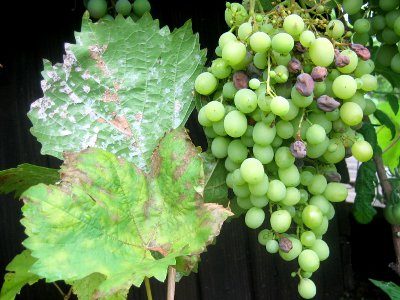 It has been noticed that the spread of oidium accelerates during periods of high atmospheric pressure. Bushes that are densely leafy or located in poorly ventilated areas are particularly affected by the disease. The safety of the future harvest depends on the attentiveness of the gardener, because the appearance of pockets of white plaque on the leaves is the earliest symptom of the disease.
It has been noticed that the spread of oidium accelerates during periods of high atmospheric pressure. Bushes that are densely leafy or located in poorly ventilated areas are particularly affected by the disease. The safety of the future harvest depends on the attentiveness of the gardener, because the appearance of pockets of white plaque on the leaves is the earliest symptom of the disease.
When infected with powdery mildew, the shoots lag behind in development, and the leaves, in addition to acquiring white spotting, often become curled.
It is important to know! The white spots on oidium are very specific and recognizable: they do not have clear contours and look as if the leaf was unevenly sprinkled with ash.
As the disease develops, the whitishness moves from the front side of the leaf to the back, then to the inflorescences and berries. The tissues under the bluish coating turn brown and then dry out.
Prevention of the occurrence of oidium is tying up the vines and removing excess shoots for better ventilation of the bush, as well as triple treatment with fungicides (Ridomil, Tilt, Fundazol, Falcon, Topsin, Tiovit Jet and others):
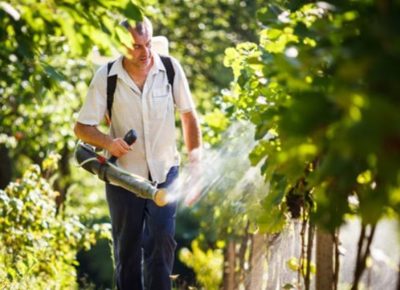
Of all the above drugs, the contact fungicide based on colloidal sulfur Tiovit Jet is the most harmless to humans, but at the same time it is less effective against the pathogen. When growing oidium-resistant grape varieties and wanting to obtain environmentally friendly products, the use of this drug will be justified.
If the cultivated varieties are not immune to powdery mildew, they should be treated with systemic fungicides, and sulfur varieties should be used for additional spraying just before the ripening of the bunch, since after such treatment the consumption of berries is allowed only a day later.
Among the most resistant to oidium are the varieties Kodryanka, Nadezhda AZOS, Marinka, Pamyati Negrulya, Platovsky, Kristall, Victoria, Harmony and Podarok Zaporozhye.
Advice from PROFESSIONAL GARDENERS Many of our readers actively use the effective biofertilizer Biogrow for a RICH HARVEST. This fertilizer is suitable for all types and varieties of grown plants. Allows increase productivity by 50% NO dangerous chemicals. And all that is needed for this is to add biofertilizer to the soil 2-3 times per season.
Mildew (downy mildew)
 The onset of the disease is easy to miss, because in humid weather its first sign - oily spots on the leaves - is not particularly noticeable. Then the back side of the leaf becomes covered with a white coating, which, if left unattended, can spread to the entire shoot in a few weeks.
The onset of the disease is easy to miss, because in humid weather its first sign - oily spots on the leaves - is not particularly noticeable. Then the back side of the leaf becomes covered with a white coating, which, if left unattended, can spread to the entire shoot in a few weeks.
It is important to know! Mildew spots, unlike oidium, have more clear contours, and the plaque itself is a fine-grained structure reminiscent of manna.
If the early stages of the disease are missed, the spots turn brown and necrosis forms in their place, leading to the leaves drying out and falling off. Spreading to the inflorescences, mildew disrupts their development and rapidly reduces the yield of the vineyard. Infection is most dangerous in the first half of summer, as it destroys the current crop. But even at the end of summer, when the bunches are formed and almost ripe, mildew does not pass without a trace, affecting the shoots and disrupting the formation of next year’s crop.
Like other mushrooms, the mildew pathogen is activated in warm, damp and windless weather, therefore correct formation a bush tied to a trellis makes a significant contribution to the prevention of the disease. Due to the ability of mildew to overwinter in fallen leaves, all plant debris from under the vineyards should be raked and burned at the end of the season, and the soil should be mulched.
 For preventive treatment with fungicides, the same three-fold approach is used as for oidium - spraying on the first leaves, on the buds and on the ovary. Among the drugs that show the greatest effectiveness are the systemic fungicides Ridomil and Mikal and contact agents Homecin, Polychom, Cuprozan or a 1% solution made from Bordeaux mixture.
For preventive treatment with fungicides, the same three-fold approach is used as for oidium - spraying on the first leaves, on the buds and on the ovary. Among the drugs that show the greatest effectiveness are the systemic fungicides Ridomil and Mikal and contact agents Homecin, Polychom, Cuprozan or a 1% solution made from Bordeaux mixture.
For varieties that are not resistant to mildew, fungicide treatment will have to be continued further, every 15 days (a total of 7–8 treatments during the growing season). However, manipulations should be stopped at least 30 days before the planned harvest date - this is the waiting period after using most of the mentioned means.
The varieties Pleven, Moldova, Kodryanka, Marinka, Vostorg, Alexa, Kesha, Talisman, Victoria, Buffalo, Arcadia, Strashensky, Laura, Victoria, Harmony and Gift to Zaporozhye have good resistance to mildew.
Anthracnose of grapes
Young vineyards of varieties resistant to powdery mildew and mildew are most susceptible to anthracnose, since for them they are usually limited to preventive measures without treating the plants regularly. This is also a fungal disease, which is caused by the pathogen Gloeosporium ampelophagum, most common in humid areas with high temperatures.
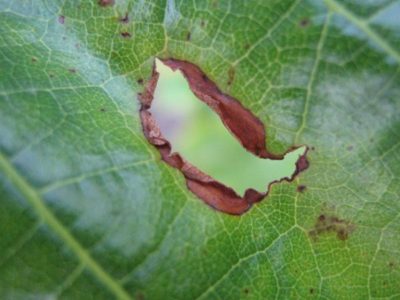 Anthracnose poses a particular danger after summer hailstorms, which damage plants and prepare hotbeds for future incubators of the pathogen. Without proper treatment, the fungus produces up to 30 generations per season, resistant to a wide range of temperatures - from +2 to +30 °C.
Anthracnose poses a particular danger after summer hailstorms, which damage plants and prepare hotbeds for future incubators of the pathogen. Without proper treatment, the fungus produces up to 30 generations per season, resistant to a wide range of temperatures - from +2 to +30 °C.
The disease is sometimes called bird's eye because of the characteristic appearance of spots on the leaf blade. At an early stage, the leaves become covered with depressed brown spots, which then grow, and their middle dries out and turns white. In later stages, the whitish areas often fall out and the leaf appears holey.
It is important to know! Anthracnose can be distinguished by the dryness of the spot and its dark border. The spots themselves resemble sunburn, and in a humid environment they acquire a bluish-pink bloom.
By infecting shoots, the fungus causes deep cracking and death. Anthracnose cankers on shoots are often confused with hail holes, without giving them due attention, but when infected, their edge always has a black border. If the disease spreads to the hands, then necrosis makes it difficult to feed them, and the bunch dries out. Affected berries do not ripen, crack and fall off. The pathogen is able to overwinter in fallen berries and infected stems, remaining viable for 5 years and spreading to neighboring plants during periods of rain and watering.
 In addition to traditional pinching, pruning and gartering, grapes need chemical protection from pathogens. In the spring, when young shoots grow an average of 10 cm, they are sprayed with copper-based contact fungicides (3% solution of Bordeaux mixture, Hom, Kuproxat), the effect of which lasts no more than 14 days, then repeated treatments are carried out at the same interval with systemic preparations ( Ridomil, Acrobat, Arcerides). After a hail event, unscheduled spraying of the vineyards should be done immediately.
In addition to traditional pinching, pruning and gartering, grapes need chemical protection from pathogens. In the spring, when young shoots grow an average of 10 cm, they are sprayed with copper-based contact fungicides (3% solution of Bordeaux mixture, Hom, Kuproxat), the effect of which lasts no more than 14 days, then repeated treatments are carried out at the same interval with systemic preparations ( Ridomil, Acrobat, Arcerides). After a hail event, unscheduled spraying of the vineyards should be done immediately.
IMPORTANT!
Does your blood pressure constantly fluctuate? After taking the pills, does it come back after a while? Hypertension can lead to stroke, heart attack, enlarged heart and eventually heart failure. Remember! Your blood pressure will be 120/80 without chemicals or pills in just 5 days. VESSELS will be restored and cleansed if in the morning on an empty stomach...
Anthracnose affects almost all varieties, but Traminer, Riesling, Rkatsiteli and Sauvignon are considered more or less resistant.
Felt mite infestation
An invisible pest, also called grape itch, reaches a length of only 0.2 mm. Mites successfully overwinter in grape buds, becoming more active when warming reaches +15 °C. When they colonize a plant, they feed on its sap, migrating to younger leaves as the leaves age. Over the course of a season, a female felt mite can produce up to 7 generations of offspring.
 Grape itch mainly colonizes only the underside of the leaves.
Grape itch mainly colonizes only the underside of the leaves.
The pest's saliva, getting into the puncture of the leaf tissue, causes the formation of pits in it, which on the front side look like brown tubercles. On the lower side, in the habitat of the itch, the spots are overgrown with white felt.
It is important to know! In order not to confuse mite infestation with mildew and not to use ineffective in this case fungicides, you just need to rub White spot: the mite felt will not be erased, while the fungal coating will be easily smeared.
The older the mite gets, the more brown the felt spot on the underside of the leaf becomes, growing in size. Individual foci merge, and the leaf curls and withers.
The felt mite itself is not very dangerous, but it can transmit viral diseases and reduces vineyard yields by limiting photosynthesis in damaged leaves. Measures against the pathogen should be taken when it damages more than 20% of the foliage mass.
 It is difficult to combat itching due to the protective felt that envelops it, especially since it is the underside of the leaves that needs to be treated. Therefore, spraying is carried out at temperatures not lower than +20 °C in order to enhance the effect of the drug vapors. The safest for the environment are colloidal sulfur and compositions based on it (for example, Tiovit Jet), as well as the biological product Fitoverm. More effective, but also toxic, are the contact acaricides Neoron, Apollo (effective only in the early stages) and Karbofos (dangerous for bees, not used during the flowering period).
It is difficult to combat itching due to the protective felt that envelops it, especially since it is the underside of the leaves that needs to be treated. Therefore, spraying is carried out at temperatures not lower than +20 °C in order to enhance the effect of the drug vapors. The safest for the environment are colloidal sulfur and compositions based on it (for example, Tiovit Jet), as well as the biological product Fitoverm. More effective, but also toxic, are the contact acaricides Neoron, Apollo (effective only in the early stages) and Karbofos (dangerous for bees, not used during the flowering period).
It has been noted that some grape varieties are of relatively low interest to the felt mite. Among them are Moldova, Strashensky, Ananasny, Lyana and Marinka.
Other causes of white spotting on grape leaves
If on grape leaves white spots appear, this may indicate a deficiency of elements important for plant development in the soil or a violation of its acid-base balance:
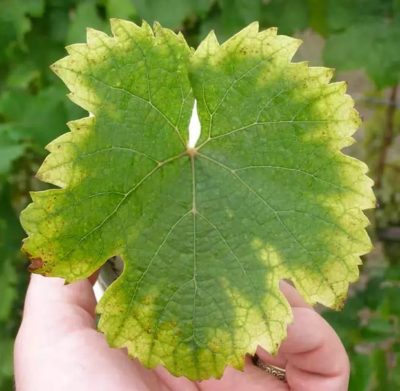
White spotting of grape leaves is not a death sentence, but only a natural interaction of living organisms that is undesirable to humans.
Timely preventive and therapeutic measures make it possible to stop the development of pathogenic processes and achieve high yields both in industrial conditions and in private household plots.
Do you still feel like getting rid of cardiovascular diseases impossible?
- Do you often experience pain and discomfort in your chest?
- it seems to you that your heart almost “jumps out” of your chest, then freezes for a while...
- you have shortness of breath even after minor physical exertion....
- headaches, poor sleep, feelings of weakness and increased fatigue...
- My legs swell in the evening...
A good vineyard is every gardener's dream. Neat vines and large fragrant clusters create a special atmosphere. How nice it is to pluck yourself in the evening ready dessert! However, growing grapes has its own difficulties, primarily because the fruit vine is very loved by pathogenic bacteria and viruses. Today we want to look at the reasons why a white coating appears on grapes.
Achievements of modern agricultural technicians
Only at first glance, the luxurious bunches grow without any effort from the gardener. The most beautiful and delicious varieties are always affected first. Despite all the efforts of breeders, this law cannot be overcome. Only varieties with mediocre taste have a certain resistance to the most formidable diseases, including mildew. But if similar grapes, for example “Isabella” with sour blue berries, is crossed with a good sweet variety, then the resistance is noticeably reduced, and you can again notice a white coating on the grapes.
Shocking variety
If you are determined to grow on your own plot delicious berries, then you will need to pay a lot of attention to this. First of all, non-infectious diseases that are caused by heat or high humidity, poor soil or excess nutrients are dangerous for the vineyard. They can be easily avoided if you ensure optimal conditions in your garden.
However, the list is not limited to this; there are hundreds more different infections. If you observe a white coating on the grapes, you will have to rack your brain as to what it is a consequence of. Infectious diseases spread throughout the vineyard very quickly. This leads to a significant loss of yield or death of the entire vine. Infection occurs through infected bushes, garden tools, as well as wind and water. Imagine all the risks, and you will understand how important constant monitoring of the garden is.

Downy mildew
Wherever there are vineyards, sooner or later mildew will sprout. Its causative agent is a fungus. It settles on living tissues and forms a white coating on the grapes. Get rid of it uninvited guest It’s not at all easy, since it overwinters on fallen leaves and in the ground and tolerates cold and heat well. During a season, 20 generations of the fungus can change.
Externally, the disease manifests itself in the form of spots. In humid weather, a white coating appears. When it is hot and dry, there are no such symptoms. To combat this disease, it is necessary to carry out preventive treatments. This will save your harvest and prevent a new outbreak.
Among the means of protection, the drugs Antrakol and Bordeaux mixture, Kuproksat, Thanos, and Khorul have proven themselves to be the best. The first treatment is performed when young shoots reach 15-20 cm in length. The second is necessary before flowering, and the third - when the berries are set.
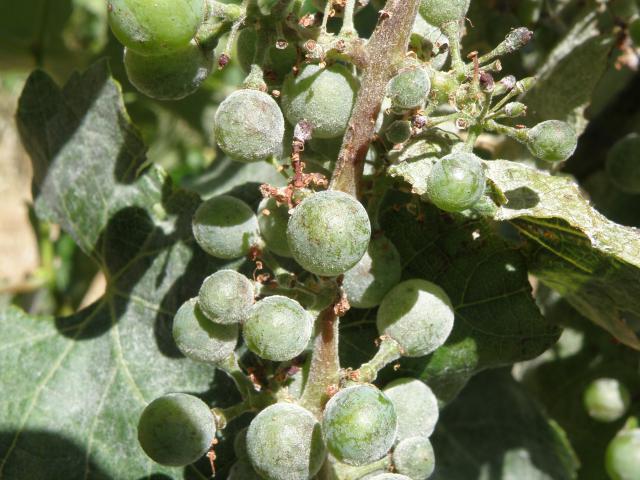
How to recognize mildew
At the initial stage of development of the disease, this is not at all easy. People usually realize that a vine is infected when it becomes serious. You will be very lucky if the summer turns out to be rainy. In damp weather, you can notice the fluff on the leaves and take action. But on hot days, even an experienced gardener will not notice the approaching disaster. You can completely get rid of mildew only by removing all the bushes from the ground. However, fungal spores can wait up to 20 years for a new vine to emerge. Its growth can be restrained annually with special fungicides, and preventive measures cannot be skipped.
Genuine powdery mildew
This dangerous disease, which causes a white coating on grapes. Scientifically it is called oidium. The disease is caused by the fungus of the same name. At the very beginning of the growth of grape shoots, an attentive gardener can find among them those that are significantly stunted in growth. Their leaves appear curly and are completely or partially covered with white dust. From June this coating becomes noticeable on the lower and upper parts of the leaves. All inflorescences and clusters look as if they were sprinkled with flour.
A white coating on the grape berries in this case indicates that big changes will soon await your vine. The fruits burst and are destroyed. Oidium causes great damage to gardening. The incubation period is very short, and therefore the disease can spread to the entire vineyard. Most often, spread occurs in damp and warm weather, as well as moderate humidity. 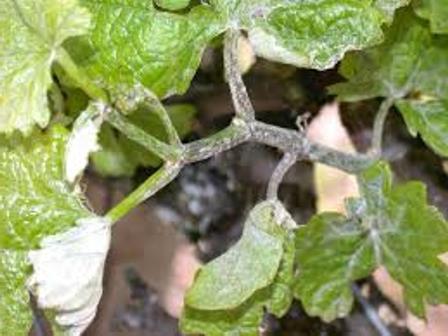
What awaits your vine
White bloom on grape leaves is just the beginning. Over time, the green mass will darken, then turn yellow and die. However, the affected leaves do not fall off, but continue to remain firmly in place. New shoots of a plant or a freshly planted vine are instantly infected. With the onset of the cold period, the plant dies completely in 3-4 weeks.
If the growth of the vine has stopped and black spots can already be found on it, then you can be sure that the plant is slowly heading towards death. Why there is a white coating on the grapes is already clear. It is destroyed by a fungus. However, even if the infection occurred at the end of summer, there is little good. Half of the crop will turn white and dry out. There's no point in hoping for a second part either. The remaining berries become soft and have a putrid taste. Winter will not bring you salvation either. The fungus will survive the cold well and finish what it started next year. 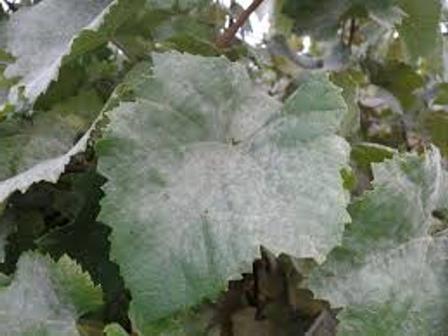
Treatment of oidium
If the grapes are covered with a white coating, you need to take immediate action. This is treatment with special antifungal drugs, such as Topaz and Strobi, Horus, Thiovit, Thanos. For treatment, you will need to repeat spraying after ten days. However, this disease is much easier to prevent than to treat. Agrotechnical techniques boil down to ventilating bushes by tying up shoots and pinching, as well as weed control. Follow the time limits for preventive treatment indicated for the treatment of mildew. 
Alternaria blight
This is another fungal disease that has been gaining popularity in recent years. Distributed almost everywhere. The hotter and rainier the weather, the more likely it is to appear in your vineyard. Affects leaves, shoots and berries. Outwardly very similar to oidium. Already 10-14 days after infection, silvery spots appear on the leaves, and then mold. A film and velvety coating is formed on the berries.
The white coating on the bunches of grapes in this case says exactly one thing - the harvest is ruined, but you need to try to save the vine itself. If the infection occurred at the end of the season, but due to too hot weather its development did not occur, then the fungus will begin to grow after harvesting and ruin it all very quickly. To determine whether a vine is infected, it is enough to take a part of the shoot that seems suspicious to you and place it in a moist environment. This will be enough to cover the material with a velvety coating.
Fighting methods
Protecting a vineyard from Alternaria blight is not too difficult, but all measures must be carried out regularly. From biological products good results treatment with Trichodermin gives. To prevent the pathogen from overwintering in the vineyard, it is very important to clean your plot in the fall and thoroughly burn all dry plants. The symptoms of this disease most often manifest themselves clearly in the second half of the growing season, but you cannot wait for them. Protective measures should begin in the spring.
Special fungicides that contain mancozeb are very suitable for this. An example is the drug "Ridomil". Starting from the period of formation of bunches, systemic fungicides should be used, examples are “Skor”, “Quadris” and “Rapid Gold”. The interval between treatments is 10-14 days. 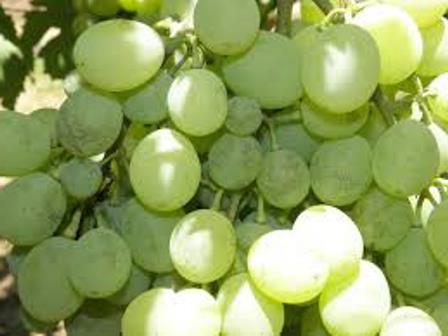
There is a white coating on the grapes: what to do?
The signs of these diseases are similar enough that it can be difficult to distinguish one from the other. In order not to waste precious time, you need to start processing immediately. Therefore, if you notice a characteristic symptom, first prepare a solution of potassium permanganate. Add just a few crystals to the water to give it a pink tint. It is very important that every leaf is moistened. Carry out this treatment in the spring, when your vine is just waking up. Even if the plant is not infected, this will be an excellent prevention.
When a white coating has already been noticed on the leaves of the grapes, what to do in this case? Purchase several complex fungicides from a specialized store and apply according to the instructions. By alternating them with each other, you will not give the fungus a chance to adapt. 
Emergency help
What to do in cases of severe damage to the vine? Let's see what to do if you missed the moment and there is already a white coating on the grapes. How to treat the vine in this case? A bucket of water will help you; you will need 10 g of active ingredient. Spraying can be done every week until the grapes bloom.
If the bush begins to turn black, then inspect your plantings. The most affected plants must be removed and burned, the rest must be carefully processed. We are no longer talking about berries; it is important to save the bushes themselves. Moreover, even if you have successfully treated by the end of the season, it is recommended to burn the bunches so that they do not become a source of spores. In the spring it will be possible to carry out preventive treatment and wait for the new harvest.
Prevention
A gardener with certain experience and knowledge must use it on his site. modern methods to avoid unpleasant consequences. It’s a little more difficult for beginners, but they too must learn to protect their garden. This is especially true for those who grow varietal grapes. The disease can affect even the most well-kept garden and spread through it with lightning speed.
At the beginning of spring, be sure to spray the vine with antifungal solutions. Late in the fall, before winding up the plant for hibernation, this procedure is repeated. But chemical treatment is not everything. Pay special attention to the soil. Grapes extract a huge amount of nutrients from it. If it is not fertilized, the vine will be susceptible to fungal diseases. It is advisable to use special mixtures for feeding that are sold in stores. Complexes that contain potassium, phosphorus, magnesium and other minerals are ideal.
It is very important to monitor the condition of the vine. The vineyard should be constantly moist, light and spacious. Therefore, the bush needs to be trimmed and tied up in a timely manner, and stepsons should be removed. A well-groomed vine is easier to inspect, and compliance with all these parameters is a kind of guarantee that the disease will bypass it.
Growing a vineyard is a troublesome, but very rewarding task. A well-groomed bush will thank you for your time with sweet berries that can be eaten directly or stored for the winter.

